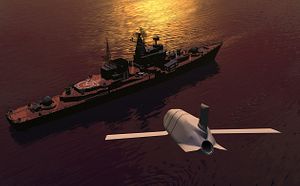U.S. defense contractor Lockheed Martin successfully conducted its first test firing of a surface-launched variant of its new Long-Range Anti-Ship Missile (LRASM) from a topside canister, the company said in a July 27 statement.
The angled launch from a topside canister, positioned at the same angle and using the same launch controls as the vertical launch system used aboard U.S. Navy surface warships, took place at the White Sands Missile Range in New Mexico. According to to the press statement, following the launch, the missile and its “Mk-114 booster and booster adapter ejected cleanly from the topside launcher using the same launch control and launch sequencer software currently employed by the Mk-41 Vertical Launch System (VLS).”
The July 27 test follows a successful test launch a LRASM prototype from an F/A-18E/F Super Hornet for the first time in April 2017.
“Integrating LRASM onto surface ships enables distributed operations beyond enemy threat ranges,” the Lockheed Martin statement reads. “Along with the already proven VLS launch capability of LRASM, this topside canister with an angled launcher allows the LRASM surface-launch variant to be employed aboard various platforms in the Navy’s surface fleet, providing the potential for a powerful new anti-ship role under the U.S. Navy’s ‘Distributed Lethality’ concept of operations.”
Distributed lethality, the U.S. Navy’s new warfighting concept, “is about having such overwhelming offensive superiority that no potential threat would consider attacking. And if for some reason they did attack, they would lose decisively and rapidly,” said former U.S. Navy Surface Warfare Officer William J. Parker III, one of the minds behind the distributed lethality concept, in an interview with The Diplomat last year.
However, as the U.S. Navy surface fleet is slowly implementing this new warfighting concept it still lacks a long-range, anti-surface missile (See: “The US Navy’s New Surface Warfare Strategy: ‘Distributed Lethality’”). The LRASM is slated to complement two other anti-ship missiles, the RGM-84D Harpoon Block 1C and the fifth-generation over-the-horizon Kongsberg Naval Strike Missile (NSM).
The LRASM started as a joint research project by the Defense Advanced Research Projects Agency (DARPA) and the U.S. Navy in 2009. The aim of the LRASM project was to deliver a new generation of anti-ship missiles with standoff capabilities. (Missiles with extended range, which would enable ships and aircraft to launch the weapon without being exposed to enemy counter fire.)
The subsonic LRASM has an estimated range of over 320 kilometers and is fitted with a 450-kilogram penetrator and blast fragmentation warhead. In July, Lockheed Martin was awarded a contract for the production of 23 air-launched LRASM, officially designated AGM-158C. The new missile will be integrated on the B-1B Lancer heavy strategic bomber and the F/A-18E/F Super Hornet by the end of 2019.

































